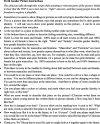The Perth Gender Picture (PGP): Young people's feedback about acceptability and usefulness of a new pictorial and narrative approach to gender identity assessment and exploration
- PMID: 34240076
- PMCID: PMC8118236
- DOI: 10.1080/26895269.2020.1795960
The Perth Gender Picture (PGP): Young people's feedback about acceptability and usefulness of a new pictorial and narrative approach to gender identity assessment and exploration
Abstract
Background: A number of psychological assessment tools have been developed to describe various dimensions of gender. Some of these tools are restricted to a binary gender concept and are inflexible in reflecting how a young person's gender may change and develop over time. Most are text questionnaires which require a good level of literacy.
Aims: This study aimed to evaluate a newly developed pictorial tool that facilitates a conversation about gender between a child or adolescent (aged 11-18) and their clinician, enabling a diverse understanding and expression of gender identity.
Methods: The Perth Gender Picture (PGP) was co-created between clinicians and young clients between 2016 and 2018. In 2018, the measure was evaluated through a pilot study at the Gender Diversity Service at Perth Children's Hospital in Western Australia. After use of the PGP during a clinical consultation, clients were invited to fill in a feedback questionnaire about their experience of its use. Clinicians participated in unstructured interviews to give their feedback.
Results: Most participants rated the PGP as easy to understand, acceptable and useful, and many stated that they found gender easier to describe with the picture rather than words. The results show positive uptake from clients, demonstrating feasible implementation with gender diverse young people.
Discussion: This evaluation positions the PGP as a useful tool to facilitate conversations about gender identity between gender diverse children and adolescents and their clinicians, in a nonjudgmental and playful manner. It is well-suited to young people who may have limited literacy or difficulty with complex language. The PGP has potential for use in other age groups and non-clinical contexts.
Keywords: Assessment; child and adolescent; gender diverse; gender dysphoria; pictorial; transgender.
© 2020 Crown Copyright in the Commonwealth of Australia. The Gender Diversity Service.
Conflict of interest statement
The authors have no other conflicts of interest to declare.
Figures




References
-
- American Psychiatric Association [APA]. (2013). Diagnostic and statistical manual of mental disorders (5th ed.). APA.
-
- Australian Psychological Society. (2018). Information sheet: Australian Psychological Society recommends mental health practices that affirm transgender people’s experiences. Australian Psychological Society. https://www.psychology.org.au/getmedia/00cd6bab-650a-431b-bc67-fdfb69729...
-
- Berg, D., & Edwards-Leeper, L. (2018). Child and family assessment. In Keo-Meier C. & Ehrensaft D. (Eds.), The gender affirmative model: An interdisciplinary approach to supporting transgender and gender expansive children. American Psychological Association. 10.1037/0000095-007 - DOI
-
- Coleman, E., Bockting, W., Botzer, M., Cohen-Kettenis, P., DeCuypere, G., Feldman, J., Fraser, L., Green, J., Knudson, G., Meyer, W. J., Monstrey, S., Adler, R. K., Brown, G. R., Devor, A. H., Ehrbar, R., Ettner, R., Eyler, E., Garofalo, R., Karasic, D. H., … Zucker, K. (2012). Standards of care for the health of transsexual, transgender, and gender-nonconforming people, V7. The World Professional Association for Transgender Health.
-
- Connolly, M. D., Zervos, M. J., Barone, C. J., Johnson, C. C., & Joseph, C. L. M. (2016). The mental health of transgender youth: Advances in understanding. The Journal of Adolescent Health: Official Publication of the Society for Adolescent Medicine, 59(5), 489–495. 10.1016/j.jadohealth.2016.06.012 - DOI - PubMed
LinkOut - more resources
Full Text Sources
Miscellaneous
